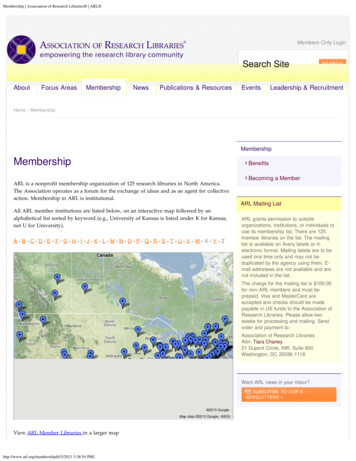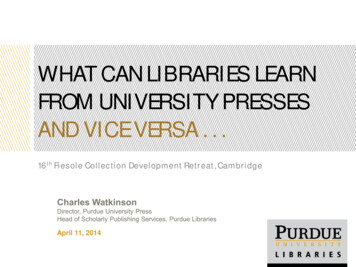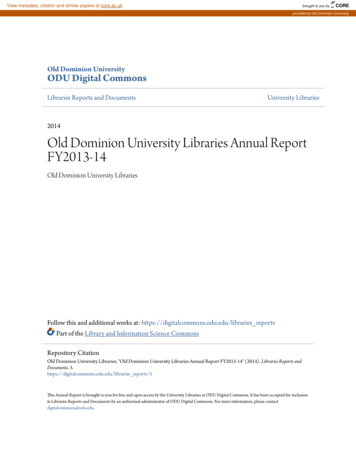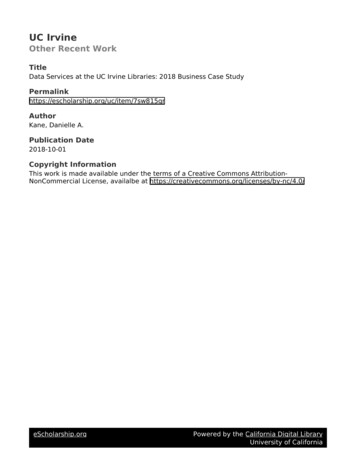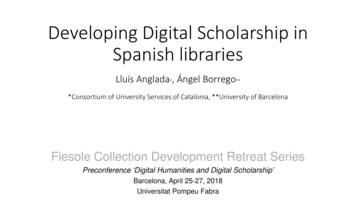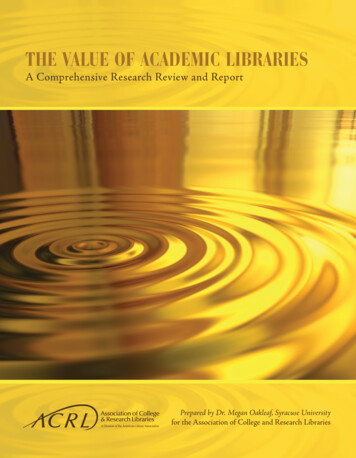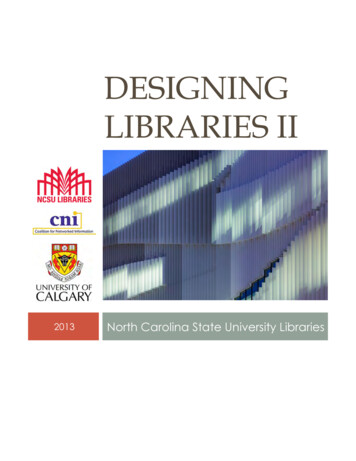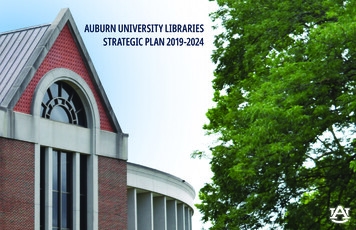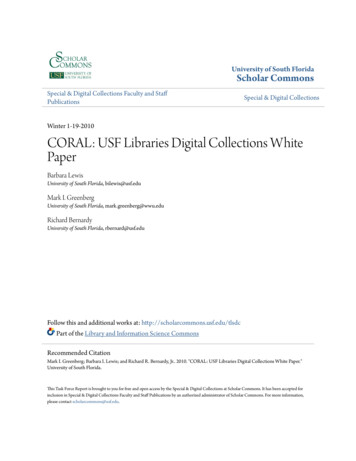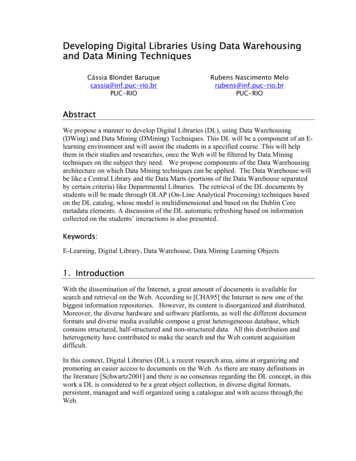
Transcription
Developing Digital Libraries Using Data Warehousingand Data Mining TechniquesCássia Blondet Baruquecassia@inf.puc-rio.brPUC-RIORubens Nascimento Melorubens@inf.puc-rio.brPUC-RIOAbstractWe propose a manner to develop Digital Libraries (DL), using Data Warehousing(DWing) and Data Mining (DMining) Techniques. This DL will be a component of an Elearning environment and will assist the students in a specified course. This will helpthem in their studies and researches, once the Web will be filtered by Data Miningtechniques on the subject they need. We propose components of the Data Warehousingarchitecture on which Data Mining techniques can be applied. The Data Warehouse willbe like a Central Library and the Data Marts (portions of the Data Warehouse separatedby certain criteria) like Departmental Libraries. The retrieval of the DL documents bystudents will be made through OLAP (On-Line Analytical Processing) techniques basedon the DL catalog, whose model is multidimensional and based on the Dublin Coremetadata elements. A discussion of the DL automatic refreshing based on informationcollected on the students’ interactions is also presented.Keywords:E-Learning, Digital Library, Data Warehouse, Data Mining Learning Objects1. IntroductionWith the dissemination of the Internet, a great amount of documents is available forsearch and retrieval on the Web. According to [CHA95] the Internet is now one of thebiggest information repositories. However, its content is disorganized and distributed.Moreover, the diverse hardware and software platforms, as well the different documentformats and diverse media available compose a great heterogeneous database, whichcontains structured, half-structured and non-structured data. All this distribution andheterogeneity have contributed to make the search and the Web content acquisitiondifficult.In this context, Digital Libraries (DL), a recent research area, aims at organizing andpromoting an easier access to documents on the Web. As there are many definitions inthe literature [Schwartz2001] and there is no consensus regarding the DL concept, in thiswork a DL is considered to be a great object collection, in diverse digital formats,persistent, managed and well organized using a catalogue and with access through theWeb.
The development of a DL generally implies in integration of distributed multimediacontent on the Web. Since the hypermedia nature of the Web implies in navigationthrough the content in order to get the desired information, the organization of theintegrated data should consider a content categorization into hierarchies.There are various initiatives which aim at developing DL whose proposal is to solve theproblem of content integration as well as the access to these contents using hierarchicalclassification [GAAS1999]. The following projects are some related works: DigitalStanford Library Technologies [PBCCG2000], Digital Illinois Library Initiative Project[Chen2000], Digital Alexandria Library Project [ACDFF 1995] and University ofDigital Michigan Library Project [WB1998]. However, it is noted that such initiatives donot present a comprehensive proposal to address the issues related to DL.A research area that has been contributing to solve complex database problems is the areaof Data Warehousing (DWing). The DWing approach has been very useful to addressissues related to data integration and complex search.The process of digital library development includes issues such as the integration ofcomplex documents found on the Web. Moreover, access to the DL must be assisted bythe use of content hierarchies that guide the user in the discovery and filtering ofinformation of his/her interest.The study of new methods for the DL development is becoming a very fertile researcharea. In some research work more emphasis is being given to the item of integration ofcomplex and heterogeneous data, using approaches such as CORBA, agents andmediators, as found in [PBCCG2000], [Chen2000], and [WB1998].Some works consider the challenges related to the semantics of the DL [Chen2000] andothers suggest the use of hierarchies classification for refinement of the user’s search, asmentioned in [GAAS1999].Some works emphasize the need for a systematic approach that allows the automation ofthe main typical library functions, such as classification, cataloguing, etc. Moreover, theproposed solutions normally are based on proprietary data which can be catalogued usingUSMARC format that is typical of traditional libraries.This work presents architecture for DL development based on the Data Warehousing(DWing) approach and using some Data Mining (DMining) techniques. DWing has beenused for data integration to give support to the decision-making process. As a result of theDWing, there is a database called Data Warehouse (DW), which is subject-oriented andpromotes content organization into hierarchies in an integrated way. On the other hand,DMining allows finding, extracting, filtering and evaluating the desired information anddigital objects, as well as tracking and analyzing the user’s standards accesses.In some areas, such as the administrative, statistics and GIS (Systems of GeographicInformation), the DWing approach has contributed to the integration of complex data andaccess to them in a satisfactory fashion. Similarly, this work contributes to the solution ofsome fundamental problems in this area.2
In Section 2, the Data Warehousing (DWing) is mapped to the “Data Librarying”(DLing) process. In Section 3 the DLing Components are presented. In Section 4 wepropose the use of data mining techniques in some of the DLing Processes. Finally, inSection 5, some concluding remarks are made and we comment about the changes wemade to the proposed work.2. Data Warehousing (DWing) and Data Librarying (DLing)2.1 - The DWing approach in the DL developmentThe DL development based on the DWing approach implies in understanding the DWingarchitecture and how to use and/or adapt its processes and components for the DL.2.1.1 Data WarehousingIn accordance with William H. Inmon [Inmon1996], a DW has the followingcharacteristics: It is subject-oriented (the data are stored in accordance with specific areas of thebusiness or specific subjects/aspects of the company interest).It is integrated (i.e., it integrates data from diverse sources, while identifying andcorrecting inconsistencies).It is a collection of non-volatile data (it means that data are loaded and accessed, butits updating does not occur in a DW environment).It is variant in time (the time horizon for DW is significantly longer than that ofproduction systems; the data consist of a sophisticated series of “snapshots” obtainedat a certain moment; and the DW key structure always consists of some temporalelements).It is used for supporting management decisions.Generally, architecture for systems based on DW involves the integration of current andhistorical data. The data sources can be internal (operational systems of thecompany/institution) or external (containing complementary data originated from theorganization, such as economic indicators). Generally, the data integration deals withdifferent data models, definitions and/or platforms. This heterogeneity demands theexistence of applications that extract and transform data in a way that the data integrationbecomes possible. Once integrated, the new data are stored in a new database - DW that combines different points of view for supporting management decisions. Thisdatabase is used for data analysis by final users. DW can be divided into some databasescalled Data Marts (DM) [Kimball96]. Such DMs contain information that can be usefulto different departments of the company. They are also considered as departmental DWs.DM/DW can be accessed by OLAP (Online Analytical Processing) or DMining toolsand/or DSS (Decision Support Systems). These tools make the data navigation possible,as well as the managerial analysis and the knowledge discovery. An important3
component of this architecture is the metadata repository, where the information aboutthe DW development can be found.2.1.2 DLing from the DWing ApproachBy applying the DW-related concepts shown above in the DL process, we observe that: A DL must be subject-oriented (as mentioned previously, it is important for the usersthat they can search for documents through a subject hierarchical classification).A DL must have an integrated view of documents. A possible distribution of thesedocuments, as well as inconsistencies, must be transparent to the final user.Documents and its corresponding metadata must be loaded only one time in the DLand its contents do not have to be updated; the users access are for reading onlyThe documents are stored in the DL and other versions can be enhanced. Moreover,the documents generally have a temporal orientation related to the publication date.So, the temporal aspect is also of interest in a DL.Finally, although a DL is not necessarily used to support management decisions, it isused to support the process of decision-making in the research. Thus, the decisionsupport characteristic is also of interest.Another aspect that is important to observe is the distinction between central and locallibraries, which becomes possible in the proposed approach through the differentiationbetween DW and DM. DW refers to the Central Library while DM refers to the Local(Departmental) Libraries.As shown in Figure 1, in the process of the DL development (DLing), the process of aDW development (DWing) occurs as follows:The data sources are not previously defined and do not consist of transactional datasources of a given company (which are generally legacy systems and relationaldatabases). They are composed by available documents on the public or private Webinstead.The extraction process, instead of using conventional data extraction tools from databasesor legacy archives, is made through the process of document search on the Web and itsfiltering. The information are accessed through traditional searching mechanisms such asYahoo, AltaVista, Goggle etc., or even by the mechanisms created specially to this endwhich can look for documents on the hidden Web [RG2001]. An additional stage consistsof the filtering of documents that are of real interest to the user.The transformation process consists of an analysis of the documents obtained in theprevious process, capturing their metadata that are necessary to the load process of thedatabase and will compose the library catalogue.The load process, beyond effectively generating the referring catalogue of the captureddocuments, makes a copy of the documents found.4
The DW contains documents of all the subjects of interest to a given institution, as wellas their respective metadata which are organized in hierarchies according to the ontology.The DM contains the documents metadata (catalogues) of all subjects relating to adepartment for which such database was generated.The search for documents and the catalogue (DW) visualization use OLAP navigationtechniques making it possible to find those whose characteristics are of interest to theuser.5
Data WarehousingDigital LibraringFigure 1 – Data Warehousing and Digital Librarying3. DLing ComponentsBearing in mind the parallel between DWing and DLing, the architecture components forthe DL development, according to the proposed approach, are detailed below (Figure 2).2.2.1 Data SourceThe DL data source or document source is the Web, both the Public Indexable Web andthe Hidden Web ([Duvillier2001] and [RG2001]). Documents can be replicated or havedifferent versions and/or be found in various visualization formats, such as archives ”txt”,”html”, ”ps” and ”pdf”. Considering the Web documents variety, a list of links which ispart of the DL development metadata repository, assists the documents searching andallows the restriction of a set of sites for search. This list considers two types of links:6
links of interest (which restricts the search of the documents to these links) andundesirable links (which disregard the documents of these links in the search). Anotherform of restricting the universe of URLs searching is through the terms defined in the DLOntology. In the proposed approach, the ontology is also part of the metadata repositoryand the DL development considers only those subjects which are of interest to theinstitution. The ontology initially defined can be modified manually (through theontology owner direct manipulation) or automatically (through mappings of newsubjects, that are searched by the library users and are not still part of the ontology).Figure 2 – DLing Architecture Components2.2.2 – Extraction ProcessA search is made initially, both on the Public and Private Web, using searching tools andtraditional crawlers, such as Yahoo, AltaVista, Lycos, Hobot, Excite, etc. Searchingmechanisms that have been developed specially to this end and are capable of fetchingdocuments in the hidden web can also be used. A summary of some search tools can befound in ([UC2000] and [RG2001]).This initial search is based on the Ontology that was built for the DL and on the links list,both located in the metadata repository. Once the search result is obtained, each item isanalyzed based on the abstract presented for it and according to the Ontology terms andrelationships.Based on this first analysis results, the items that seem to be of more interest are analyzedmore deeply. The documents are then analysed in more detail.7
2.2.3 - Transformation ProcessIn this process, data needed to compose the DL catalogue are obtained. The documentsthat had been selected and extracted in the previous process are analyzed here. Theirbibliographical information is extracted, in accordance with the standard of Dublin Coremetadata [NISO2001] and the DL ontology, and then they are stored in the operationalcatalogue.It is also in this process that the link mapping is updated. The document is analyzed andchecked to verify whether it is already registered or not in the operational catalogue. Inpositive case, the document link (physical) is added to the links list. In negative case, thedata are added to the operational catalogue, a logical link is created for it and the logicaland physical links are added to the link list. Each updating of the links list implies inthe updating of the undesirable links list.2.2.4 – Load ProcessIn this process, the new data of the operational catalogue, as well as their respectivedocuments, are loaded in the DL. The load in the DL considers the multidimensionalmodeling for the data of the catalogue.Documents that contain copy restriction will not be stored in the DL but theirbibliographical references will be included in the DL catalogue. So, there is not a"cache" of these documents, which become inaccessible in case their original web serversare down.2.2.5 - Digital libraryIn the DL all the documents whose copies had been allowed are stored, as well as theirrespective bibliographical references. These bibliographical references compose the DLcatalogue that is modelled multidimensionally. Thus, the DL is organized based on asubject hierarchical structure and the analysis dimensions (user search) are based on theDublin Core metadata standard.2.2.6 - Local librariesThe local libraries store the bibliographical records of interest to a certain department.The local library catalogue is originated from a DL mapping based on a subgroup of theontology related to the department that will also be stored in the metadata repository.2.2.7 - OLAPThe OLAP tool allows the documents retrieval from multidimensional navigations in thecatalogue. A search initiates from a certain term (or set of terms). The result is presentedthrough summaries of the documents characteristics. These summaries are quantitativegraphical representations according to the analysis dimensions. The user can navigate8
through the dimension hierarchies, filter the result based on some characteristics andexplore the Catalogue by using the navigation functions of the OLAP tools.When the desired document is found, the user can access it through physical links(URLs). In case the site is not available or the document has been removed from the sitethe DL cache can be used (when there is one available).As the user searches in a local library and does not find the documents that meet hisneeds, the searched terms that he used for the search are analyzed and then can beautomatically included in the ontology. As such, the DL is sensible to what the userssearch. It is like a library that learns what can be stored in it based on the use the usersmade of it.2.2.8 - MetadataThe metadata repository is composed by: the definition of the DL ontology, the links list(interesting and undesirable), the definitions of the Ontology subgroups (according to thecompanies/institutions) and the DL and local libraries schemas.2.2.9 - Links MonitorThis component monitors the links of the selected objects. The link list is updated ateach physical link changing.4. DMining in DLing4.1 - Using Data Mining Techniques in the DLing ProcessesHaving seen the DWing approach for DLing, the DMining definitions as well as the useof the DMining Techniques in DLing are presented below.4.1.1 - Data MiningThe Internet, in particular the Web, has promoted the increase in the volume of availableinformation. Because of this, it is increasingly more difficult to get the desiredinformation. This calls for the use of techniques and tools which can automatically find,extract, filter and evaluate the available resources. Similarly the easiness of navigation onthe Web and the competition among the various sites have generated the necessity tofollow and to analyze standards of the users' accesses. In order to satisfy these needs,DMining techniques is being used.According to [CMS1997], a natural combination of DMining and the Web, generallyreferred to as Web Mining, has been the focus of many papers and projects of recentresearch. As in any other emerging area, there is not still a formal definition of WebMining, as it is the case of DL. Generically, Web Mining can be defined as the discoveryand analysis of useful information on the Web. This information can be analysed in terms9
of content and use of the resources called Web Content Mining and Web Usage Mining,respectively.Web Content Mining describes the automatic search and recovery of information andavailable resources located in Web sites and online databases. Web Usage Miningdescribes the discovery and analysis of user’s access standards to one or more Webservices or services on line, when the Web access logs and other users’ navigationalinformation are analysed.According to [Loh1997], Web Content Mining can be divided in two sub-areas: themining in the information retrieval (searching) and the mining in the informationextraction (in the case of textual documents, it is called textual analysis). Web UsageMining would be the mining for discovery and analysis of access standards to the site inquestion.Considering the proposed approach and the proposed architecture, we can point the use ofdata mining in the processes presented below:ExtractionIn this process, it was decided to use the DMining techniques for the informationextraction in two phases: initially, when the result of the search on the Web presents apage with the links found and their respective summaries; and, later, when the text isselected, the idea is to use filtering techniques in both phases. Although the DLingapproach is sufficiently generic for the multidimensional resources, in this first step of theproposed architecture development only the textual objects are being considered.TransformationIn this process, the bibliographical records related to the selected documents will begenerated using the Dublin Core metadata standard. The mining technique for theinformation retrieval is applicable in this stage, once the keywords to compose themetadata tags will be extracted from the documents. The main information extractiontechniques recognize the structures of a text (data or information) through the taganalysis, generally represented by keywords.OLAPIn this process, it is expected that the results of the searches in the library are analyzedusing mining techniques for the information discovery. When a term analysis is not inthe ontology and it indicates a new way of research, that is, an interesting aspect to beincluded in the ontology, this new term and its respective relationships with the Ontologyexisting terms will be included in the ontology.10
5. Conclusion and Future WorkIn this paper we proposed a new approach to the development of digital libraries. Sincethe main issues in the DL development are complex data integration and difficultinformation retrieval, we proposed the development of the DL based on the DataWarehousing approach, since it is being efficiently used in the integration of complexdata and in the assistance in the information retrieval. We correlated the DWing andDLing processes, described each of their components and defined the DW as being theCentral Libraries while de DMs as being the Local Libraries.Another research area that has been solving information extraction, retrieval anddiscovery issues is the Data Mining area. As such, the data mining techniques are usefuland applied, in three of the Digital Librarying processes: Extraction, Transformation andOLAP. These techniques will allow the filtering of the really interesting documents inthe Extraction Process, the generation of the Dublin Core Metadata, using the keywordsfound in the selected objects, and, finally, and automated refresh of the library,discovering the users needs through the analysis of their accesses standards.As we mentioned in the beginning of this paper, in this work a DL is considered a largeobject collection, in diverse digital formats, persistent, managed and well organized usinga catalogue and accessed through the Web. Initially we restricted the scope of the DL totextual objects only. Now, after reviewing our proposal and being involved with thePGL Project, we are suggestion the use of this approach to LOs. It fits very well to sortout the access problem to the various LO-DL (Learning Objects Digital Libraries) whichwill compose our project as well as those found on the Web.Our goal is be to integrate the various LOs repositories or PGL LOs Digital Librariesand/or others, through the diverse metadata standards integration, thus building a unifiedDW. .The DW, or DL, would become LO-DL (Learning Object Digital Library), containing theCatalogue (in Dublin Core Metadata) of all the LOS that are of interest to our Project.DMs would be created in accordance with the needs of the users searches. An exampleof a DM (local LO-DL) could be a Catalogue pointing to LOs written in Portuguese andfor children of a certain age range.BibliographyACDFF 1995 Andresen, D., Carver, L., Dolin, R., Fischer, C., Frew, J., Goodchild,M., Ibarra, O., Kothuri, R., Larsgaard, M., Manjunath, B. S., Nebert, D.,Simpson, J., Smith, T. R., Yang, T., Zheng, Q.; “The WWW prototype ofthe Alexandria Digital Library”, In the Proceedings of ISDL'95:International Symposium on Digital Libraries, Japan, ages75/17.html11
Chen2000Chen, H.; “The Illinois Digital Library Initiative Project: FederatingRepositories and Semantic Research”, 997Cooley, R., Mobasher, B., Srivastava, J.; Web Mining: Information andPattern Discovery on the World Wide Web, 1997, http://wwwusers.cs.umn.edu/ mobasher/webminer/survey.htmlDuvillier2001 Duvillier, L.; The Hidden Web, 2001,http://europa.eu.int/comm/development/ publicat/courier/courier 184/en/en 070 ni.pdfGAAS1999Geffner, S., Agrawal, D., El Abbadi, A., Smith, T.; Browsing Large DigitalLibrary Collections Using Classification Hierarchies, In Proceeding of theCIKM’99, 1999Inmon1996Inmon, W.H.; Building the Data Warehouse, John Wiley & Sons, Inc.,1996Kimbal1996Kimball, R.; The Data Warehouse Toolkit, John Wiley & Sons, Inc.,1996Loh1997Loh, S.; Knowledge Discovery in Text Databases, 1997,http://www.ulbra.tche.br/ loh/apostilas/dc-texto.html (in portuguese)NISO2001NISO; The Dublin Core Metadata Element Set, An American NationalStandard, National Information Standards Organization (approved by theANSI in September, 2001)PBCCG2000Paepcke, A., Baldonado, M., Chang, C.K., Cousins, S., Garcia-Molina,H.; “Building the InfoBus: A Review of Technical Choices in theStanford Digital Library Project”, 2001Raghavan, S., Garcia-Molina, H.; “Crawling the hidden Web”, . In theProceedings of the 27th Intl. Conf. on Very Large Databases (VLDB),Italy, 2001RG2001Raghavan, S., Garcia-Molina, H.; Crawling the Hidden Web, hwartz2001 Schwartz, C.; “LIS 462 – Digital Libraries Definitions”, 2001,http://web.simmons.edu/ schwartz/462-defs.htmlUC2000UC Regents, Internet Search Tool Details, s.html12
WB1998Weinstein, P., Birmingham., W.; “Organizing Digital Library Contentand Services with Ontologies”, International Journal on Digital Libraries,special issue on artificial intelligence for digital libraries, 199813
Data Warehousing Digital Libraring Figure 1 - Data Warehousing and Digital Librarying 3. DLing Components Bearing in mind the parallel between DWing and DLing, the architecture components for the DL development, according to the proposed approach, are detailed below (Figure 2). 2.2.1 Data Source
